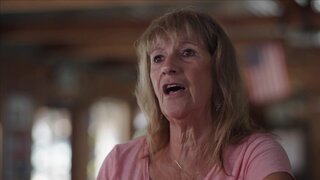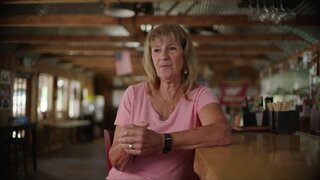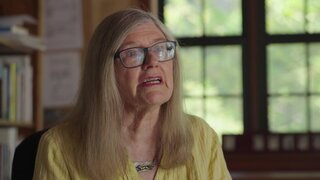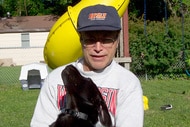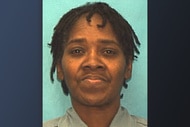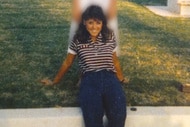Create a free profile to get unlimited access to exclusive videos, breaking news, sweepstakes, and more!
A Mountain Town Double Shooting Reveals Twisted Plot Of Greed And Betrayal
The new proprietor of a California Mountain lodge was found shot to death in bed, resulting in a whirlwind investigation that, ultimately, resulted in zero conviction.
A wealthy out-of-towner and her employee are shot at her upscale California mountain lodge, sending investigators scrambling to find a killer on the loose.
In the early morning hours of Aug. 19, 1990, at around 3:30 a.m., Camp Nelson Lodge employee Rudy Manuel called 911, reporting that he and the lodge’s newest proprietor, Bonnie Hood, had just been shot. When Tulare County officials arrived, they found Bonnie dead in her bed – a .38-caliber slug embedded in the headboard – and a trail of blood across the resort after Manuel crawled to get help.
Bonnie died instantly after suffering a gunshot wound to the head, while Manuel survived with just a graze.
“A point of entry was determined to be at the rear door,” retired Tulare County Sheriff’s Office detective Juan Morales told “Blood & Money,” airing Saturdays at 7/8c on Oxygen. “There was a screen that was cut, and there were some pry marks found.”
Morales said nothing about the crime scene indicated a burglary and that whoever shot the pair had “the intent to kill.”
Looking into the murder victim, Bonnie Hood and her husband, Jim Hood, lived in affluent Newport Beach, California, with their two children, about a 4.5-hour drive south of Camp Nelson. Bonnie, who used to vacation at Camp Nelson as a child, and Jim, a construction developer, had recently purchased the lodge, fulfilling what they hoped would be a new chapter for Bonnie.
Bonnie carved out her schedule to make the 240-mile drive from home to Camp Nelson to tend to the business every odd weekend and hired Rudy Manuel as an on-site caretaker to look after the place while she was away.
Initially, investigators wondered if Bonnie was the sole target of the shooting. After all, it was well-known that Camp Nelson locals were less-than-enthusiastic about having elite out-of-towners — like the Hoods — purchasing property in the area. There was also speculation that a romance had blossomed between Bonnie and caretaker Manuel.
“You can’t dispute the evidence we found at the scene, which was that they were both in the same bed on the night of the shooting,” according to Det. Morales.
Detectives visited Manuel at the Valley Medical Center in Fresno, hoping to glean information about the shooter. Manuel admitted he and Bonnie were having a romantic affair. He also helped law enforcement officials create a sketch of the suspect.
Helen Erb, one of the Tulare County EMTs who’d responded to the shooting, was working nearby at the Pierpoint Lodge the night before. She remembered seeing a suspicious stranger at her bar, making off-color comments to patrons.
“The lady he was sitting next to approached me and said, ‘I really don’t like that guy sitting next to me.’ I said, ‘Not a big deal, I got it,’” said Erb. “I walked out from behind the bar and said, ‘I’m sorry, sir, but we don’t need your kind in here.’”
Where the stranger went afterward would remain a mystery.
But employees at the Pierpoint lodge — one of the two only area lodges aside from the Hoods’ Camp Nelson Lodge — recalled the stranger had brought in his own beer, which seemed unusual. Luckily, the bottle was still behind the bar when detectives came to collect it as evidence.
Meanwhile, Jim Hood traveled to Camp Nelson, arriving hours after the murder. Investigators verified he was hours away when his wife was killed, but it was worth noting that Mr. Hood stood to gain hundreds of thousands of dollars in life insurance policies in the event of Bonnie’s death.
“The lodge, it became a, kind of, black hole; just sucking all the money out of their finances,” said author and Camp Nelson vacationer, Tinker Lindsay. It seemed the Hoods couldn’t get the business traffic they’d anticipated.
Investigators wondered if money could be the motive, as the life insurance money, theoretically, would have been plenty to recoup the lodge’s lost funds and then some. But with Jim having an alibi, law enforcement continued their investigation, leading them to Rudy Manuel’s sister – who also worked at the Hoods’ lodge. The sister remembered seeing two roofers in the area days before the murder, one she believed could have resembled Manuel’s composite sketch.
Officials identified the roofers as Fresno-based brothers Mark and Matthew Stewart. Though neither resembled Manuel’s description, the brothers’ friend, Rick Lamar, had. Later, Manuel — while still hospitalized — positively identified Lamar as the shooter.
Lamar, however, claimed he was away on a fishing trip with his father, and after his alibi checked out, investigators were back to square one.
“I didn’t get the feeling Lamar or his dad were involved,” said Det. Morales. “There was no connection to Mr. Lamar and Bonnie Hood or Rudy Manuel.”
A break in the case came when on Oct. 11, 1990, - weeks after the murder – the Tulare County Sheriff’s Office’s Violent Crimes Unit found the prints on the mysterious stranger’s beer bottle matched a man named Bruce Beauchamp of Fontana, California.
Witnesses placed Beauchamp at Hoods’ lodge, as well as the nearby Pierpoint Lodge, around the time of the murder. Helen Erb was certain Beauchamp was the mystery man she had to remove from the bar, and Manuel — who was no longer in the hospital — identified him as the shooter.
Manuel had no idea who Beauchamp was, though Beauchamp admitted to being at Camp Nelson on the weekend of the shooting, claiming he was supposed to meet a date who never showed. Beauchamp said he went between both the town’s lodges for a few beers before making the four-hour drive back to Fontana in the middle of the night, but the story didn’t make sense to investigators.
“He had been drinking, and then be able to stay awake while he drives all the way to Fontana?” Morales commented. “It didn’t add up.”
Any suspicions cast on Beauchamp only intensified when learning he was employed by the victim’s husband, Jim Hood, who owned a construction company in Fontana.
A closer look revealed both the Hoods’ business and marriage “were coming apart,” according to San Bernardino County Assistant District Attorney Grover Merritt. Investigators wondered if Mr. Hood paid Beauchamp to have his wife killed. After all, he did have several motives, including selling the lodge for profit, life insurance policies, and revenge for Bonnie having an extramarital affair, investigators believed.
Bruce Beauchamp was arrested for the shooting.
It would be an uphill battle for prosecutors, however, as there was no physical evidence tying Beauchamp to the Camp Nelson crime scene. And to admit that Mr. Hood hired him to kill Bonnie would only implicate himself in the homicide.
Beauchamp’s murder trial began at the Tulare County Courthouse in Visalia, California, on Feb. 28, 1991. And if the circumstantial battle wasn’t enough, the star witness, Rudy Manuel, had his credibility called into question when jurors learned he’d identified two people as the shooter (first, Rick Lamar, then Bruce Beauchamp). For unknown reasons on the stand, Manuel also denied having a romantic affair with Bonnie Hood.
On March 29, 1991, Beauchamp was found not guilty and acquitted of the charges, meaning he couldn’t be re-tried for the case, according to A.D.A. Merritt.
But things took a dark turn when one year after the acquittal, on March 22, 1992, Jim Hood made a disturbing 911 call, claiming he’d just shot a man at his Mission Plaza industrial office in Fontana. The victim was Bruce Beauchamp.
“He just tried to kill me,” Hood cried to dispatchers, as heard on 911 recordings. “A man just tried to kill me, and I shot him.”
When deputies arrived, Beauchamp was lying on the office floor, dead in a pool of blood. According to Hood, Beauchamp showed up with a gun in his hand, prompting Hood to take a gun from his drawer and fire first in self-defense.
But the crime scene struck detectives as peculiar, finding Beauchamp’s gun never fell from his grip and that he’d been shot seven times. It also appeared strange that Beauchamp’s hand and gun fell over an abundant amount of blood spatter, though there was no blood spatter on the weapon or Beauchamp’s hands.
“What that indicates is the hand was there after the blood spatter hit the floor,” according to criminalist Craig Ogino of the Los Angeles County Coroner’s Office.
It also transpired that the gun was found in Beauchamp’s right hand, although he was left-handed.
“We think he [Hood] staged the scene inside his office before he called the sheriff’s department,” said A.D.A. Merritt.
Jim claimed Beauchamp confronted him about a construction snafu involving Beauchamp’s brother-in-law, but detectives didn’t buy the story, ultimately arresting Hood for Beauchamp’s murder. They wondered if Beauchamp’s homicide was tied to Bonnie Hood’s 1990 murder.
“The two killings were inextricably tied together,” according to Merritt. “Mr. Beauchamp was hired to kill. He got acquitted, much to Mr. Hood’s surprise, and that made him a very dangerous man to Jim Hood because he was free to point the finger at Jim Hood.”
The trial began at the San Bernardino County Superior Court in January 1993. One of the key witnesses would be Beauchamp’s wife, Sharon Beauchamp, who gave damning testimony that her late husband had, in fact, allegedly confessed to murdering Bonnie.
Sharon said she accidentally found an envelope containing $10,000, which Beauchamp claimed was part of his $50,000 payment to kill Bonnie on behalf of Mr. Hood. Beauchamp allegedly went back to Hood after his acquittal to extort him for more money, the widow alleged. Beauchamp allegedly told Hood he’d reveal Hood hired him to kill his wife unless Hood paid up.
“Bruce had asked him to wire money, and Jim said ‘no,’” Sharon Beauchamp told the court. “That he had to come back, and they would settle it.”
Despite the evidence, jurors couldn’t decide on Hood’s guilt, and the case ended with a mistrial.
During the retrial in November 1993, a new panel of jurors heard Hood’s version of events, which reportedly contradicted his previous version of events in the first trial in which he testified that he killed Beauchamp in self-defense when Beauchamp allegedly confronted him with a gun.
But when the first trial’s jury was allowed to testify about what they’d heard in the first trial — challenging Hood’s new claims — Hood was found guilty of first-degree murder for the murder of Bruce Beauchamp.
He was sentenced to 29 years to life and spent 23 years at the California Men’s Colony until his April 2017 release.
“It’s just a shame,” said author Tinker Lindsay when thinking back to Bonnie’s murder. “When I picture Bonnie now, I think of her in her jeans and her flannel shirt, blond hair down, sitting on Mulberry, her horse, riding the trails.
“I think she’s still up there in Camp Nelson,” Lindsay continued. “I think that was her happy place.”
No one has ever been convicted of Bonnie Hood’s 1990 murder.
For more stories like this, watch "Blood & Money," airing Saturdays at 9/8c on Oxygen and streaming online.

